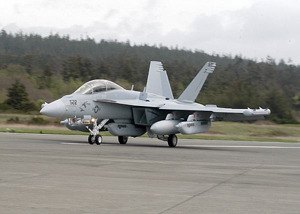Residents of the San Juan Islands, especially those living on the south side of Lopez and San Juan, probably think the name the Navy chose for its new EA-18G electronic warfare aircraft – “Growler” – is fitting.
Even though complaints from the San Juans represent less than one percent of the total noise complaints received at the Whidbey Island Naval Air Station, according to Mike Welding at NAS Whidbey, islanders from as far away as Waldron Island are telling the Journal and the county council that they are bothered by increased noise from the new planes, which are gradually replacing the 1970’s era EA-6B Prowlers as the fleet’s electronic warfare jets.
The naval air station is conducting its third environmental review in 10 years of noise and other impacts from thousands of landings and takeoffs conducted at Ault Field near Oak Harbor and the Outlying Landing Field near Coupeville. The EIS is prompted by the addition of 13 more EA-18s and a contract to train Australian pilots on the planes at NAS Whidbey.
The prior reviews were environmental assessments; this EIS is more extensive and is conducted under the more strict National Environmental Protection Act standards and rules.
The perception of increased noise and increased frequency of operations has generated more local complaints on Whidbey Island, and a citizen’s group called Citizens of the Ebey’s Reserve for a Healthy, Safe & Peaceful Environment filed a lawsuit against the Navy in July. The Navy suspended training flights for six months in 2013, but resumed them this month.
NAS Whidbey is a busy place. Last year, according to information supplied by the base, flight operations at Ault Field numbered close to 74,000, which includes every departure, landing and engine test. Field Carrier Landing Practices, often referred to as “touch and goes,” numbered more than 15,000 at Ault Field and under 7,000 at OLF Coupeville in 2013. The number of EA-18s (“VAQs” is the navy designation) will increase to 79 in 2014 and 92 in 2018. By 2016, all EA-6B Prowlers will be retired.
Because his residency district includes Lopez Island, closest in distance to the naval air station, Councilman Jamie Stephens has been informally designated as the council point man for NAS Whidbey, but all three councilmen have received complaints and have relayed those complaints to the Navy.
Stephens has visited the base and communicated the recent concerns of Lopezians, some of whom have told Stephens of more overflights and a “different sound” from the new planes.
“I’m supportive of the military,” Stephens said, “but I want NAS Whidbey to work with our communities to limit flights that go over people’s houses at night.”
“I’ve heard complaints from all the islands,” said Councilman Rick Hughes. “I support the military mission on Whidbey, but I also want to make sure the naval base is considerate of their neighbors.”
NAS Whidbey spokesman Mike Welding acknowledges that the EA-18s have a different sound than the EA-6 Predators. He doesn’t think the decibel level is higher, but admits the more powerful EA-18 engines have a “lower frequency” that may be more noticeable and that the more powerful engines and the shock wave from the planes may rattle windows more than previously. People on Whidbey Island have complained of broken glass after EA-18s have roared over their homes.
“We perform a critical mission at NAS Whidbey,” Welding said, but he also acknowledges that a full-scale environmental impact statement is important to both the base and the community. “We are studying various alternative actions and schedules, and we’ll have a full EIS for review and comment in 2015,” said Ted Brown, public affairs officer with the Fleet Force Command in Norfolk, Va., which is conducting the EIS,
Even though the Navy has held three community scoping meeting for the EIS, Welding says the base still wants to hear from local citizens who are affected by the airplanes. Comments and noise complaints should be provided to NAS Whidbey Island at (360) 257-6665, or via e-mail: comments.NASWI@navy.mil. For other questions and information, call NAS Whidbey Island Public Affairs Office at (360) 257-2286.




